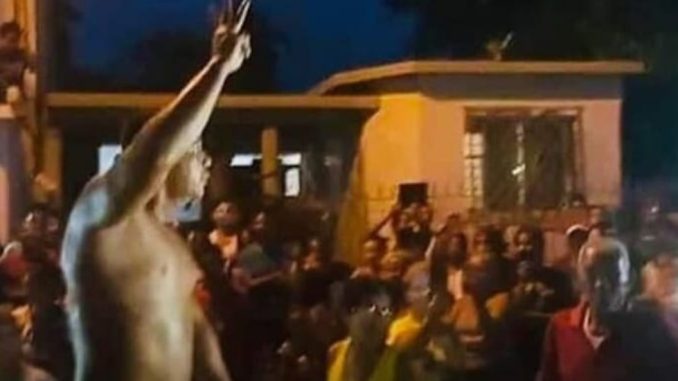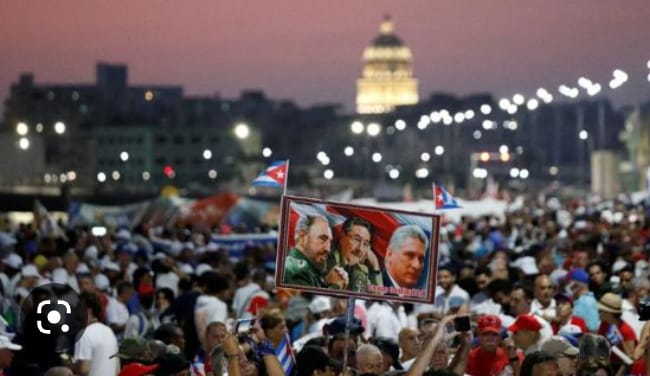
Cubans are once again suffering a worsening of their already precarious living conditions. The crisis in Venezuela, the consequences of the Russian invasion of Ukraine, the continuity of the U.S. imperialist blockade and the worsening of the social and economic crisis on the island translates into fuel shortages and lack of food. This expresses itself, for example, in the almost absolute rationing of proteins that has been implemented. For instance, only children under 13 and the sick have access to the distribution of items like chicken.
By Zuleika Matamoros
The process that began in July 11, 2021, is still open. New Protests in Guantanamo
This Saturday, May 6, a new episode of protests took place in Guantanamo. The main slogan of the hundreds of people who gathered around the municipal headquarters of the Communist Party of Caimanera was “We want food, not more speeches!”
It is a genuine process with just demands that the parasitical right-wing and U.S. imperialism seek to take advantage of and monopolize. But there are also sectors of the revolutionary left, who are anti-imperialist and critical of the Castro bureaucracy and its capitalist restoration, which have arisen within the island and need the international support of revolutionaries to fight for influence in the process against imperialism.
Since the protests that took place on July 11, 2021, there has been an open process in the Cuban population. Decades of control of information on the island, where all the media are in the hands of the State and managed by the government bureaucracy begins to crack with technological advances and the use, albeit limited, of social media. That is why the first repressive measure is to cut Internet access, in order to prevent the protests from spreading nationally and reaching the country’s political center in Havana.
The La Caimanera protest shows that the Cuban government is being increasingly questioned, to the point that this year it had to postpone one of its most important propaganda events: the May Day march, which has served as a platform to display the Cuban working class’ support for the regime’s anti-worker measures. Their justifications for holding it on Friday, May 5, before the media were “weather instability” and “fuel shortages.” Basically, what they wanted to avoid was a popular protest on such an emblematic date.

Since July 11, 2021, there have been scattered and disorganized protests. This mobilizing exercise, however, has allowed many Cubans to gain confidence in their own strength, causing spontaneous protests to take place, without political leadership and with permanent attempts by the Cuban far-right wing based in the United States to coopt them.
In the year 2022, the protests did not go away and, apparently, this year 2023 the mobilizing force of a population that has no organization, nor parties or movements, continues to be revived, precisely because the single-though regime criminalizes independent organization, which ends up facilitating the influence of U.S. imperialism and the Cuban emigres over the sectors who mobilize for just demands.
The immediate triggers of the protests have been the blackouts and food shortages, together with the continuing poverty imposed by the imperialist blockade and the policies of the ruling bureaucracy. However, the population’s exhaustion with a totalitarian regime leads them to situate these objective elements under the slogan of Freedom!
It is not socialism, it is the continuity of capitalist restoration
Since the 1990s, after the fall of the Berlin Wall, Cuba adopted a policy of “capitalist restoration” under the mixed economy model. Thus, State capitalism with transnational capital in the tourism sector and in the main sectors of the economy such as nickel, food and beverages, among others, has been justified by left wing campists who continue to define Cuba as socialist, when it has been demonstrated that what exists there is a bureaucratic nomenclature of the Cuban Communist Party, but with a capitalist policy that gives way to a new bourgeoisie, which cannot be achieved without destroying the purchasing power of the working class, which has been depleted over decades, and with a hardening of repression against the protests that take place in a country without any democratic freedoms.

“The devil is in the details,” just as in Venezuela, whose government acts as a younger brother to the Cuban one, while the working class is harshly punished and precariousness and hunger scourge the majority of the population, the traditional bourgeoisie and the Bolivarian bourgeoisie show off their wealth with gross ostentation. Likewise, in Cuba, while the shortage of food and fuel and the serious failures in public services plague the working class and the poor, the new Cuban bourgeoisie, especially linked to the gastronomic and tourist sector, has guaranteed access to the food supplies that are lacking on the table of the working class.
If one conclusion can be drawn from the current situation in Cuba and Venezuela, beyond the distance and the differences, it is precisely that the formation of a new bourgeois caste or the strengthening of the traditional bourgeoisie is not possible without first destroying the purchasing power of the workers and prohibitively controlling their forms of organization.
In Cuba, the average monthly wage established as minimum income is equivalent to 19 dollars a month, a pyrrhic income only surpassed by Venezuela, which has recently implemented a wage bonus, leaving the value of the minimum wage at 5 dollars a month.
Faced with this scenario of capitalist super-exploitation, of the elimination of the value of labor, of the prohibition of any democratic freedom, the Cuban economy is being privatized at an accelerated pace with the participation of the State. The neo-bourgeois bureaucracy of the new rich serves the table to foreign capitals, including those of Miami-based Cubans who are part of the Cuban bourgeoisie abroad, now owners of capital on the island. This is the deception contained in the supposed opening of “cuentapropismo” and the formation of “small and medium businesses,” which are impossible to carry out for any Cuban living on the island with precarious wages and miserable living conditions.
Neo-Stalinism and false progressivism cause setbacks in class consciousness
The Cuban population, which has been subjected to decades of socialist propaganda in the most grotesque form of political propaganda and the impossibility of finding spaces of political organization and activity due to the almost absolute eradication of the revolutionary left on the island, comes to the conclusion that socialism is hunger, misery, censorship and corruption.
The scenario is similar to that of Venezuela in this sense, the eradication of left wing sectors, the criminalization of revolutionary dissidence, the crushing of any expression of the revolutionary left, opens an impressively fertile ground for the reactionary ideology of the traditional right.
That is why the slogans in the genuine protests that arise are usually imposed by the anti-communist leaderships based in Miami. The weakness of the left is exploited by the ideological reaction of the right, which in turn provides the bureaucracy the opportunity to accuse every protest of being orchestrated from the United States.
In Cuba, opposing the regime from the left is a high crime. That is why it is difficult for the revolutionary left operating underground to find people willing to join the struggle for more socialism and revolution. This is the same conclusion drawn by the population of Eastern Europe and large sectors of the social base in countries like Nicaragua or Venezuela.
The legal prohibition to organize in any way outside the PCC and its organizations, and the absolute control of the unions by bureaucratic officials, leaves the working class and the population with an absence of fabric to organize itself. Hence, the difficulty in transforming the spontaneous participation in protests into organization and programmatic proposals from a working class perspective. Despite all this, the arrests of protest participants is the Cuban government’s weapon to put the icing on the cake of repression.
Supporting left wing sectors in the Cuban protests: a task for revolutionaries
In Cuba there is an incipient process of open mobilization that breaks through the propaganda apparatus of the Cuban bureaucracy. What remains is the path of repression, but it seems that the fear in important sectors of the population is overcome by the desperation produced by living without food security and under the subjugation of a regime that is increasingly being questioned.
For now, the scenario of mobilization, under the conditions that the population finds itself in has great possibilities of being coopted by the most reactionary and anti-communist sectors present on the island and supported by the United States. Castroism and its allies open the big door for them.
But a sector of the revolutionary left is growing in Cuba and must count on the support from abroad of internationalist organizations, so as to not give up the leadership of the process to the right and imperialism. That is what we are attempting to do from the International Socialist League, to support the just demands and genuine processes from the left, separated and in opposition to the Cuban exlie right and imperialism, with campaigns that pose the role played by the Cuban bureaucracy in the rise of far-right sectors and the retreat of class consciousness. Raising a program and slogans from a working class perspective.
It is time to win the heads of the left wing sectors who are critical of the Cuban neo-Stalinist bureaucracy, it is time to win the heads of the young Cubans who have only known hunger and repression, who do not even know democratic freedoms. It is time to weave a common fabric with these sectors. Let us begin by making the denunciations, but also our proposals, known. Let us remove the idea that anything is better than the current situation, because neoliberalism is not a solution for the working class anywhere in the world and the restorationist policy that has already been in place for decades in Cuba today is neoliberal, its economic programs are no different from an openly capitalist government.








